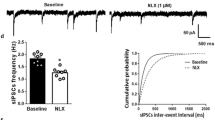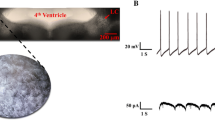Summary
The release of 14C-ACh from rat nucleus accumbens slices, induced by 15 mM [K+], was inhibited by the µ- and δ-opioid agonists DAMGO and DPDPE, respectively, whereas only the κ agonist U50,488 reduced the release of 3H-DA.
The opioid receptors involved appear to be localized on nerve terminals, since blockade of action potential propagation by 1 μM TTX did not diminish the inhibitory effects of DAMGO, DPDPE or U50,488.
Enhancement of the potassium concentration in the superfusion medium to 56 mM with simultaneous reduction of the Ca2+ concentration from 1.2 mM to 0.12 mM induced a release similar to that caused by 15 mM K+ and 1.2 mM Ca+. Under this conditions, the inhibitory effects of both DAMGO and DPDPE on stimulated 14C-ACh release were reduced, whereas the inhibition of evoked 3H-DA release caused by U50,488 was not affected. Activation of µ- as well as δ-opioid receptors by DAMGO and DPDPE, respectively, inhibited forskolin-stimulated adenylate cyclase activity. However, increasing the intracellular cAMP levels with 0.3 mM 8-bromo-CAMP affected neither the depolarization-induced release of 14C-ACh or 3H-DA from accumbens slices nor the inhibitory effects of opioid receptor activation thereon.
The results indicate that the mechanism by which functional µ- and δ receptors presynaptically inhibit the depolarization-induced 14C-ACh release from nucleus accumbens slices is likely to involve an increase of potassium channel conductance. In contrast, activation of κ-opioid receptors, which inhibits depolarization-evoked 3H-DA release, apparently does not result in a hyperpolarization of (dopaminergic) nerve terminals. In none of these inhibitory effects presynaptic adenylate cyclase appears to be involved.
Similar content being viewed by others
References
Allgaier C, Choi BK, Hertting G (1990) Forskolin modulates acetylcholine release in the hippocampus independently of adenylate cyclase activation. Eur J Pharmacol 181:279–282
Allgaier C, Daschmann B, Sieverling J, Hertting G (1989) Presynaptic κ-opioid receptors on noradrenergic nerve terminals couple to G-proteins and interact with the α2-adrenoceptors. J Neurochem 53:1629–1635
Childers SR (1991) Opioid receptor-coupled second messenger systems. Life Sci 48:1991–2003
De Vries TJ, Hogenboom F, Mulder AH, Schoffelmeer ANM (1990) Ontogeny of μ-, δ- and κ-opioid receptors mediating inhibition of neurotransmitter release and adenylate cyclase activity in rat brain. Dev Brain Res 54:63–69
Dismukes K, De Boer AA, Mulder AH (1977) On the mechanism of alpha-receptor mediated modulation of 3H-noradrenaline release from slices of rat brain neocortex. Naunyn-Schmiedeberg's Arch Pharmacol 299:115–122
Drukarch B, Schepens E, Schoffelmeer ANM, Stoof JC (1989) Stimulation of D2 dopamine receptors decreases the evoked in vitro release of 3H-acetylcholine from rat neostriatum: role of K+ and Ca2+. J Neurochem 52:1680–1685
Gandhi VC, Ross DH (1988) The effect of κ agonist U50,488H on 3H-nimodipine receptor binding in rat brain regions. Eur J Pharmacol 150:51–57
Heijna MH, Padt M, Hogenboom F, Portoghese PS, Mulder AH, Schoffelmeer ANM (1990) Opioid receptor-mediated inhibition of dopamine and acetylcholine release from slices of rat nucleus accumbens, olfactory tubercle and frontal cortex. Eur J Pharmacol 181:267–278
Illes P (1989) Modulation of transmitter and hormone release by multiple neuronal opioid receptors. Rev Physiol Biochem Pharmacol 112:141–233
Laurenza A, McHugh Sutkowski E, Seamon KB (1989) Forskolin: a specific stimulator of adenylyl cyclase or a diterpene with multiple sites of action? Trends Pharmacol 10:442–447
Mansour A, Khatchaturian H, Lewis ME, Akil H, Watson SJ (1988) Anatomy of CNS opioid receptors. Trends Neurosci 11:308–314
Miyake M, Christie MJ, North RA (1989) Single potassium channels opened by opioids in rat locus ceruleus neurons. Proc Natl Acad Sci USA 86:3419–3422
Mogenson GJ, Yim CY (1981) Electrophysiological and neuropharmacological-behavioral studies of the nucleus accumbens: Implications for its role as a limbic-motor interface. In: Chronister RB, Defrance JB (eds) The neurobiology of the nucleus accumbens. Hear Inst Electrophysiol Res, Brunswick, pp 210–229
Mulder AH, Schoffelmeer ANM, Stoof JC (1991) On the role of adenylate cyclase in presynaptic modulation of neurotransmitter release mediated by monoamine and opioid receptors in the brain. Ann NY Acad Sci 604:237–249
North RA, Williams JT, Surprenant A, Christie MJ (1987) µ- and δ-receptors belong to a family of receptors that are coupled to potassium channels. Proc Natl Acad Sci USA84:5487–5491
Paxinos G, Watson C (1986) The rat brain in stereotaxic coordinates, 2nd edn. Academic Press, London
Salomon Y, Londos C, Rodbell M (1974) A highly sensitive adenylate cyclase assay. Anal Biochem 58:541–548
Schoffelmeer ANM, Wemer J, Mulder AH (1981) Comparison between electrically evoked and potassium-induced 3H-noradrenaline release from rat neocortical slices: Role of calcium ions and transmitter pools. Neurochem Int 3:129–136
Schoffelmeer ANM, Wierenga EA, Mulder AH (1986) Role of adenylate cyclase in presynaptic α2-adrenoceptor- and µ-opioid receptor-mediated inhibition of 3H-noradrenaline release from rat brain cortex slices. J Neurochem 46:1711–1717
Schoffelmeer ANM, Hogenboom F, Mulder AH (1988a) Sodium-dependent 3H-noradrenaline release from rat neocortical slices in the absence of ektracellular calcium: presynaptic modulation by µ-opioid receptor and adenylate cyclase activation. Naunyn-Schmiedeberg's Arch Pharmacol 338:548–552
Schoffelmeer ANM, Rice KC, Jacobson AE, Van Gelderen JG, Hogenboom F, Heijna MH, Mulder AH (1988b) µ-, δ- And κ-opioid receptor-mediated inhibition of neurotransmitter release and adenylate cyclase activity in rat brain slices: studies with fentanyl isothiocyanate. Eur J Pharmacol 154:169–178
Stoof JC, Tilders FJH (1989) Dopamine receptors in the central nervous system. In: Flückiger E, Müller EE, Thorner MO (eds) The role of brain dopamine. (Basic and clinical aspects of neuroscience, vol 3). Springer, Berlin Heidelberg New York, pp 31–45
Van Vliet BJ, Mulder AH, Schoffelmeer ANM (1990) μ-Opioid receptors mediate the inhibitory effect of opioids on dopamine-sensitive adenylate cyclase in primary cultures of rat neostriatal neurons. J Neurochem 55:1274–1280
Werling LL, McMahon PN, Cox BM (1989) Effects of pertussis toxin on opioid regulation of catecholamine release from rat and guinea-pig brain slices. Naunyn-Schmiedeberg's Arch Pharmacol 339:509–513
Werz MA, Graga DS, MacDonald RL (1987) Actions of mu, delta and kappa opioid agonists and antagonists on mouse primary afferent neurons in culture. J Pharmacol Exp Ther 243:258–263
Author information
Authors and Affiliations
Additional information
Send offprint requests to M. H. Heijna at the above address
Rights and permissions
About this article
Cite this article
Heijna, M.H., Hogenboom, F., Mulder, A.H. et al. Opioid receptor-mediated inhibition of 3H-dopamine and 14C-acetylcholine release from rat nucleus accumbens slices. Naunyn-Schmiedeberg's Arch Pharmacol 345, 627–632 (1992). https://doi.org/10.1007/BF00164575
Received:
Accepted:
Issue Date:
DOI: https://doi.org/10.1007/BF00164575




